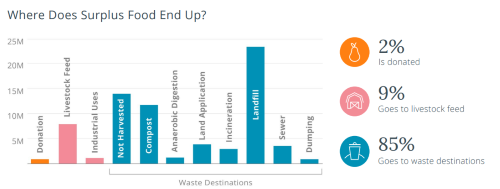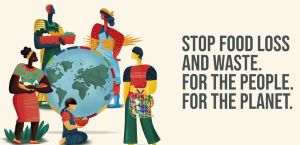Reduce, Feed People, Then Compost
Print this Article | Send to Colleague
Linda Norris-Waldt
Executive Director
Do you ever worry about feedstock competition when it comes to food waste?
Well, consider this: our share—the inedible part—of the food scrap pie is 22%, or 13.8 million tons per year of the 62.5 million tons of food scraps disposed annually.¹

That’s a pretty hefty total, unfortunately or fortunately, depending on your vantage point, and we share that inedible food pie with others, such as animal feed and anaerobic digestion. But even so, there is plenty of inedible food to go around¹.
That’s an important fact to recognize when you consider that food scrap composting infrastructure continues to be woefully inadequate. While it is growing consistently, it is growing slowly. From 2023’s BioCycle/Closed Loop Partners Study: “Using the maximum tons of food waste composted based on our 2023 data (2.6 million tons), today’s composting infrastructure processes up to 4% of the 66 million tons of total food waste generated annually in the U.S.” (Source: U.S. EPA). USCC’s estimates are that we would need 300-500 facilities nationwide to:
- Convert from collecting only yard trimmings/green waste (the majority of facility feedstocks) by expanding into Tier 2/3 facilities with permits
- Incentivize/start up new facilities, especially in areas where we have “compost deserts”²
Back to that 13.8 million tons of inedible food scraps that we are still tackling. Our throughput study showed only 643,528 tons of food scraps processed with a 36% response rate—we've got a long way to go, baby!
Some people have wondered why USCC supports things such as the Food Date Labelling Act, which would clarify that if a food business includes a date label, they must select between one of two options: a quality label indicating estimated peak freshness (using the phrase “BEST If Used By”) or a discard label indicating when a food product should be discarded (using the phrase “USE By”). By clarifying date labels, we can save consumers money and ensure that perfectly edible food is reaching people who need it instead of being prematurely discarded.
Decreasing inedible food because of the many reasons it becomes inedible—outdated labeling, inefficient buying or food prep habits, etc.—is a good move for our world, and we should support reducing food scraps and support getting food that CAN be eaten to the hungry people in the world.
Have you ever checked into the Ohio State study that watched what students would do if they knew that their overloaded lunch plates would be composted? They wasted more food when they knew it could be composted! This is not something our industry is about: we are about finding that 13.8 million (or more) tons of inedible food and composting it.
So when there is a Food Loss and Waste Awareness Day in your community, like the recent International Day of Awareness of Food Loss and Food Waste, or here in the USA, Food Waste Prevention Week, be there in solidarity.

¹ ReFEDs 2016 Roadmap to Reduce U.S. Food Waste to 20% is the number USCC has used for consistency in predicting the need for more food scrap compost facilities in the U.S. Those numbers, of course, have shifted over the years, with ReFEDS 2025 report showing wasted food scraps growing to 73.9M Tons, which would bring the inedible share to 18.5M tons.
² USCC’s Composting State of Practice study, performed by the Environmental Research and Education Foundation, identified mountains/plains states and south central states as areas lacking infrastructure.

